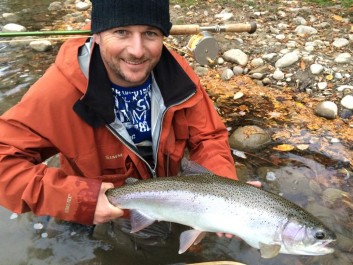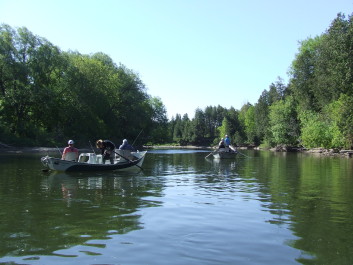Steelhead are the glamour fish of the Great Lakes and while they are not indigenous, they have been around long enough that they have been raised to the elite level of game fish. Although they take second fiddle to other species in terms of their popularity, (it would be hard to argue that walleye and bass are the most sought-after game fish in our region) those that do hunt for them on a regular basis would argue that no other fish in The Great Lakes water shed provide the same quality of sport as the elusive and enigmatic steelhead.
I say enigmatic because if there is one thing that we know about these magnificent fish is that they provide no real guarantee and can leave one frustrated, confused and humbled. That is the nature of migratory fish no matter where you are and the old saying, ‘Here today and gone tomorrow’ could not be more appropriate.

Keith Blair with an early Saugeen steelhead.
There are however a handful of things that an angler can do that will tip the scales in favour of the hunter and if you follow these rules, you will have far greater success.
1/ Steelhead move. Unlike resident trout, the piece of water that you fished and had success in just day’s before, may not hold fish today. Depending on the numbers of steelhead in a river, there is a good chance that fish that have moved on will be replaced by others but it’s not a guarantee and for that reason, you need to be prepared to move. They go with the flow and any good bump in the water levels will encourage them to carry on, so it pays to use common sense. The science suggests that on average and in the right conditions, steelhead can move about 20 kms a day but have been tracked at up to 40 kms. Moving with the fish will put you over more fish.
In a year such as the one we are currently experiencing, I prefer to take my clients on walk and wade trips rather than utilize drift boats as I don’t like committing myself to just 10 or 12 kms of river. I would rather have the ability to make big adjustments, 2 or 3 times during the day to locate fish.
2/ Holding water is critical. As steelhead move, they will typically rest on the upstream reaches of rapid or obstacles in the river. Tailouts are always a good bet in the fall as they often provide depth, cover and a nice cushion for the fish that have had to deal with the more shallow, quick riffles. A number of things will determine how long they hold in each rest area but as a general rule, the majority of movement takes place during the night so it is a good bet that on a stable river, the fish will hold there for the majority of the day.
Long runs are a good bet as well and we typically look for structure in the form of large boulders or variations in the river bottom to provide current breaks. A perfect run should have a walking pace current, three to five feet of depth and the aforementioned structure. We look for fish to hold ahead of large rocks as the current will slow considerably as it piles against the rocks. The downstream side of larger rocks will also provide a break so it pays to spend a bit more time when you come across structure like this through your run.
3/ Water temperature will play a major role. Steelhead, like all salmonids are happiest in water temperatures between about 48 degrees F and 65 degrees F. In these conditions, they will remain aggressive and content. It is also within this range that the majority of migration will occur so once again, the ability to pull up stakes and move on from one beat to another will pay off.

The colder it gets, the slower your presentation needs to be.
As temperatures drop however, daily migration will slow exponentially. Once the water temperature drops below 40 degrees F, we start to look for fish to take up station in larger, deeper wintering water. If the temperatures remain there, steelhead will remain in these pools sometimes until spring before continuing on their way to suitable spawning areas.
The other area that temperature plays a large role is in your presentation. During higher temperatures, fish will be more aggressive and more apt to move for a fly so intermediate sink tips or even long monofilament leaders can be fished and the speed of your fly is less important here. As the water temperature drops, however, it is vital that you slow your presentation down. Below 45 degrees F, slow, deep swung flies will prevail and keeping it down throughout the swing will precipitate the need for heavier tips and a slow, deliberate swing. The take from fish in these temperatures will more often than not, be very subtle and will often feel like nothing more than a heavy pause in the swing so be prepared to tighten up on any variation in the swing.
4/ Don’t worry about “matching the hatch”. Firstly, you won’t find a lot going on at this time in terms of hatches but the fact is, steelhead are not feeding heavily during their migration run. Within days of leaving the lake and committing to the river, their feeding slows to the point that considering food sources is a waste of effort. It is far more important to locate fish and present a fly that they can see rather than consider what they might be eating.
The three most commonly excepted theories as to why steelhead and salmon take flies are:
- Imprinting: Feeding behavior from the fish’s early life in the river to its sea or Great Lakes roaming adulthood leaves an impression that stays with it. Parr and smolts feed and act just like trout during their time in the river after hatching. Aquatic invertebrates (caddis, mayflies, stoneflies, etc.) make up the majority of their diet with small vertebrates (minnows fry etc.) augmenting it. They feed voraciously during these stages prior to leaving the river for the ocean and the theory of “imprinting” relies less on their ability to recall or remember this behavior but more of an instinctive reaction triggered by their return to the river’s environment.
- Aggression: This theory is based on the idea that virtually no feeding occurs during spawning and that the single priority of both sexes is to procreate. This is not difficult to accept given what salmon and steelhead endure to reach suitable breeding habitat. In other words, the fish take on a “let nothing get in our way” attitude. The presence of a properly presented artificial fly in the proximity of a holding salmon or steelhead could trigger an aggressive response leaving the fish no option but to eat it or at least bite it. (Most fish have no other defensive weapon other than their mouths and their speed.)
- Curiosity: (taken from Brian Daverns article ‘Choosing flies for Steelhead’ Fly Fisherman magazine, April 1980) “All higher forms of life exhibit curiosity at times; it’s reasonable to assume that this fact can assist us in catching steelhead. Consider yourself watching what you know to be a white marble rolling slowly towards you. Unless you have a specific interest in marbles, you probably wouldn’t pick it up, being satisfied that it is a marble. On the other hand, if it passed you so quickly that you had no chance to see it well, you may chase it and pick it up. Who knows, it might be a pearl.”
We believe that it make more sense to study the three theories together, rather than attempting to disprove one, in favor of the other.
Great Lakes Steelhead provide some of the most spectacular sport in our region but are not for the faint of heart. They require work, discipline and an extraordinary amount of patience. The reward however, is well worth it. If you follow and practice with an open mind these four points, you will be on your way to becoming a better steelhead angler.
Related articles https://ontarioflyfishing.ca/2015/02/ontario-fly-fishing-guides-secrets-to-success-understanding-behavior/
